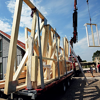1. Preparatory work
Chamfer the edge of the foundation projection. Remove adhesion-reducing components.

Current regulations
When the new DIN 1853 series of standards came into force, the previously valid DIN 18195 series of standards, ‘Waterproofing of buildings’, was withdrawn. Since then, the contents of DIN 18533 ‘Waterproofing of building components in contact with the ground’ have been decisive for waterproofing in the plinth area. With the reorganisation of the national series of standards, more comprehensive planning principles for the selection of waterproofing types have been developed. For example, water exposure class W4-E was introduced specifically for the base of buildings. In addition to waterproofing against capillary water in and under walls, the abbreviation W4-E also defines waterproofing against splash water and ground moisture in the wall base. In addition to the new planning specifications, tried-and-tested waterproofing products that have not yet been standardised, have been included in the standard. The inclusion of crack-bridging mineral waterproofing slurries (MDS) is particularly relevant for the plinth area.

Splash water and floor moisture at the wall plinth

Plinth waterproofing in detail
-
Single-shell masonry, basement
-
Single-shell masonry, no basement
-
Single-skin masonry with WDS system, basement
-
Double-shell masonry, no basement
-
Double-skin masonry with plaster
-
Connection to full-length windows and doors
Plinth waterproofing in timber frame construction

Peace of mind guaranteed
Benefit from our expert advice, our promise of optimum safety for our extensive product range, and our express delivery service.
Express delivery
Our express delivery is the ideal service for anyone who needs their order to be delivered fast.
Specialist representatives directly on site
Our specialist representatives are on hand to provide you with personalised support and advice – wherever you are.
Extensive product range
From building and floor protection products through to wood preservatives, we have everything you need!
Systems with Remmers guarantee
You can be sure of a reliable and high-quality solution for every application.





















